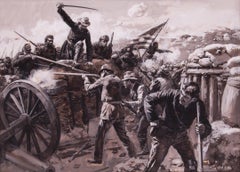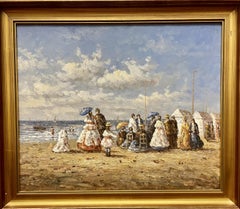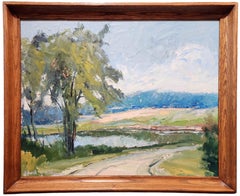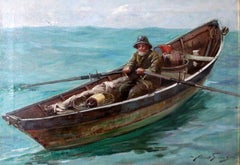Abbott Fuller Graves Art
American, 1859-1936
Abbott Fuller Graves was an American painter and illustrator who specialized in decorative open air garden paintings and floral still lifes. His use of thick brushstrokes, bright colors, and natural light shows the influence of European impressionism.
Graves was born in Weymouth, Massachusetts, on April 15, 1859, the son of James Griswold Graves and Eliza Nicholls (Fuller). Hoping to become an architect, Graves attended the Massachusetts Institute of Technology but did not graduate. Graves went to Paris and Italy in 1884 to refine his skills as a flower painter. In Europe, he roomed with Edmund C. Tarbell. After returning to Boston in 1885, Graves became a teacher at the Cowles Art School, where his friend Childe Hassam was also on the faculty. The two painters undoubtedly influenced one another. In 1887, Graves returned to Paris to study figure painting at the Academie Julien.
Graves returned to Boston in 1891, and lived in the coastal town of Kennebunkport, Maine, where he taught painting classes in oil and watercolor. He continued to visit there in later years, painting genre scenes featuring farmers, fishermen, firemen and old sea captains of Kennebunkport. Many of his portrayals of small-town life were reproduced on calendars and postcards.
After 1891, the majority of Graves's works depict gardens and floral landscapes, some including female figures. Some portray exotic gardens of Spain and South America. In 1891, he opened his own art school in Boston. The school later moved to Kennebunk, Maine. From 1902 to 1905, Graves was employed as a commercial illustrator for magazines and studied at the Académie Vitti in Paris. After 1922, Graves spent his winters in New York City, where he belonged to such organizations as the National Academy of Design, the National Arts Club, the Salmagundi Club and Allied Artists of America.
Examples of Graves’s work can be found in public and private collections across the country, including the Mead Art Museum at Amherst College, the Arnot Art Museum, Elmira, New York; the Brick Store Museum, Kennebunk, Maine; Ball State University Museum of Art, Muncie, Indiana; the Hermitage Foundation Museum, Norfolk, Virginia; and the Princeton University Art Museum, Princeton, New Jersey.(Biography provided by Helicline Fine Art)
to
2
2
2
1
1
Colonel Bates Leads the 30th Colored Infantry at the Battle of the Crater
By Abbott Fuller Graves
Located in Costa Mesa, CA
Colonel Bates Leads the 30th Colored Infantry at the Battle of the Crater
Watercolor on Paper Circa 1903
15 ½ x 21 ½ Inches 25 ½ x 33 ½ Inches Framed
LR: Graves
This rare portrait of African American troops serving in battle during the Civil War depicts the 30th United States Colored Infantry at the Battle of the Crater, at Petersburg, Virginia. The regiment was composed of African American enlisted men commanded by white officers and was authorized by the Bureau of Colored Troops which was created by the United States War Department on May 22, 1863.
The Battle of the Crater, July 30th, 1864, was part of the Siege of Petersburg, fought between the Confederate Army of Northern Virginia, commanded by General Robert E. Lee and the Union Army of the Potomac, commanded by Maj. Gen. George G. Meade (under the direct supervision of the general-in-chief, Lt. Gen. Ulysses S. Grant).
At the top of the painting, Colonel Delevan Bates raises his saber to lead the charge of the 30th United States Colored Infantry. Bates was promoted to this command just prior to this battle, having served with distinction in the 121st New York Infantry at the Battles of Fredericksburg, Chancellorsville and Gettysburg. Though the Battle of the Crater would eventually be won by the Confederacy, it was here that Bates and 23 other troops would be award the United States highest award for bravery during combat, the Medal of Honor.
After weeks of preparation, on July 30, Union forces exploded a mine in Maj. Gen. Ambrose E. Burnside's IX Corps sector, blowing a gap in the Confederate defenses of Petersburg, Virginia. From this propitious beginning, everything deteriorated rapidly for the Union attackers. Unit after unit charged into and around the crater, where soldiers milled in confusion. Grant considered the assault "the saddest affair I have witnessed in this war." The Confederates quickly recovered and launched several counterattacks led by Brig. Gen. William Mahone. The breach was sealed off, and Union forces were repulsed with severe casualties. Brig. Gen. Edward Ferrero's division of black soldiers...
Category
Early 1900s American Realist Abbott Fuller Graves Art
Materials
Paper, Watercolor
Hollyhocks
By Abbott Fuller Graves
Located in Greenwich, CT
This museum quality and rare American Impressionist garden scene is in an exceptional gilt frame. The dimensions listed are for the item in total framed size. The canvas inside the...
Category
1920s Impressionist Abbott Fuller Graves Art
Materials
Canvas, Oil
Related Items
Edwardian Beach Scene, British 20th century oil on canvas
Located in Hillsborough, NC
Richly-colored and vibrant Edwardian Beach Scene, British oil painting on canvas in impressionist style, presented in contemporary gold frame. The oil paint is raised and textured, lifting the beach sands, sea, sky and dresses from the canvas. Gathering in Edwardian period costuming looks out over the sands to the sea and clouds, with distant sailboats and children playing in the waves.
This is a delightful contemporary painting, unsigned, but original oil dating to the 20th century. Framers tags verso from Oxford and Glasgow.
In very good condition, with a few minor chips on the gold frame, but otherwise the painting is bright and beautiful.
Provenance to gallery in the United Kingdom, imported by Saltire Gallerie...
Category
20th Century Impressionist Abbott Fuller Graves Art
Materials
Canvas, Oil
The Pond, Godfrey's Pond, Batavia, New York, Stafford, American Landscape
Located in Grand Rapids, MI
Stuart E. Zillman (American, 20th Century)
Signed: Stuart E. Zillman (Lower, Right)
" The Pond ", c. 1960s (Possibly Godfrey's Pond)
Oil on Canvas Board
16" x 20"
Housed in a 1...
Category
Mid-20th Century American Impressionist Abbott Fuller Graves Art
Materials
Canvas, Oil
Venice Landscape Italian Oil on Canvas Painting in Gilt Wood Frame, Belle Epoque
Located in Firenze, IT
This delightful turn of the century (early 20th century) oil on canvas painting represents an Italian landscape with one of the most famous squares in the world: Piazza San Marco in ...
Category
Early 20th Century Impressionist Abbott Fuller Graves Art
Materials
Canvas, Oil
Venice Landscape Italian Oil on Canvas Painting in Gilt Wood Frame, Belle Epoque, Early 20th Century
H 51.19 in W 33.47 in D 1.19 in
Temple of Paestum, Max Usadel (ca. 1880-1950), 1912, Oil Paint on Canvas
Located in Greding, DE
Max Usadel (ca.1880-1950), Temple of Paestum, dat. 1912
View of the temple of Paestum with two ox carts in the foreground. The setting sun creates a dramati...
Category
1910s Impressionist Abbott Fuller Graves Art
Materials
Canvas, Oil
H 37.41 in W 52.37 in D 1.19 in
The Gateway
By Eleanor Parke Custis
Located in New York, NY
Signed (lower right): ELEANOR PARKE CUSTIS
Category
20th Century American Realist Abbott Fuller Graves Art
Materials
Paper, Gouache
Parisian Street Scene
By Luigi Cagliani
Located in Greenville, DE
Luigi Cagliani (1910-1987) Paris street scene mid 20th century. Signed lower left. In a beautiful 17 x 19.5in hand carved period frame.
Category
Mid-20th Century Impressionist Abbott Fuller Graves Art
Materials
Canvas, Oil
Illustration for the Brothers Grimm fairy tale "Rapunzel"
By Simon Kozhin
Located in Sempach, LU
In 2023, after 20 years, he returned to the illustrations of the Brothers Grimm fairy tale "Rapunzel". I wanted to write a couple of stories from a fairy tale, although the series ha...
Category
2010s American Realist Abbott Fuller Graves Art
Materials
Paper, Watercolor
H 9.73 in W 11.74 in D 0.04 in
Fishermen, Bahamas (North Carolina artist)
By Frank Stanley Herring
Located in Wilton Manors, FL
Beautiful ca. 1935 painting by American artist, Frank Stanley Herring (1894-1966). Watercolor on heavy rag handmade paper measures 14.5 x 19 inches, 23 x 28 inches in original vintag...
Category
1930s American Realist Abbott Fuller Graves Art
Materials
Handmade Paper, Watercolor
1840 rare watercolor, Native American encampment, Western Indian Unknown artist
Located in Buffalo, NY
A rare mid 19th Century watercolor depicting Native Americans approaching a fort.
The subjects appear to be from a Northern Plains Tribes, and arre approaching a palisades style f...
Category
1840s American Realist Abbott Fuller Graves Art
Materials
Paper, Gouache, Watercolor
Pulp Magazine Marine Combat Scene Shoot Out in Blue Noir
Located in Miami, FL
What makes this work important?
It's not that it's a commissioned artwork for a men's 60s pulp adventure magazine depicting the instant a soldier is shot. The big point of the painting is how brilliantly the formal elements are thought out, designed, and executed. John McDermott tells a story using a complex figural composition in an unexpected wide-angle vision. The work is as abstract as it is representation. His use of light is significant because it creates a high-contrast two-color style that bears the mark of its creator. This is a work done by a master artist/illustrator without peers compared to artists living today. If the contemporary art world gave awards for draftsmanship, painting technique, and graphic design .... John McDermott would win the highest accolades.
Initialed lower left - unframed
John McDermott (August 30, 1919 – April 20, 1977), also known under the pen names J.M. Ryan and Mariner, was an American illustrator and author noted for action and adventure illustrations.[1] McDermott worked as an in-between and effects animator for Walt Disney Studios and as a US Marine combat artist,before establishing himself as a cover illustrator for 1950s paperbacks and pulp magazines such as Argosy, American Weekly, and Outdoor Life. Under his J.M. Ryan pen name, he wrote the novels The Rat Factory (1971), a derogatory satire of Walt Disney and the Disney studio; Brooks Wilson Ltd (1967), on which the 1970 film Loving was based; and Mother's Day (1969) about Ma Barker. Under his own name, he novelized director-writer Bo Widerberg's screenplay for the 1971 film Joe Hill, which would be his final published book.
Early life
John Richard McDermott was born 30 August 1919 in Pueblo, Colorado, the younger of two sons of Henry McDermott, an oil broker. McDermott was a young child when his father committed suicide.[4] The family eventually moved to Los Angeles where McDermott's mother, Hazel, worked in a beauty parlor. He graduated from Hollywood High School in 1936. Although he had had no formal art education, he took a job as an artist at Walt Disney Animation Studios.
Career
Disney
At Disney, McDermott worked as an in-betweener and effects animator on Brave Little Tailor, Pinocchio, The Reluctant Dragon and Fantasia. His experiences while working at Disney, particularly during the time of the 1941 Disney animators' strike, would later become the basis for his 1969 satirical novel The Rat Factory. McDermott left Disney to fight with US forces during World War II.
US Marines
McDermott World War II sketch titled "Buddy is Wounded"
On September 29, 1942, McDermott enlisted with the US Marine Corps. He served as a "pistol and palette" combat artist assigned to the map-making section. As a sergeant with the III Amphibious Corps, McDermott was involved in battles in the South Pacific theater of war, documenting the Guam, Okinawa and the Guadalcanal Campaigns. McDermott considered his wartime years to be his art education.
"In the Marines, as a combat artist, I traveled with the troops and for three years got all the drawing opportunity anyone could want. My work changed enormously during this time and I’m sure it was due to constant drawing, every single day, from life, just putting down what I saw around me. In a few instances it was a dangerous kind of scholarship."
According to the Marine Corps history journal Fortitudine, McDermott was so prolific that his contemporary style pen-and-ink sketches became easily recognizable to both Marines, from published work in Leatherneck Magazine, and civilians, from glossy copies supplied by the Marine Corps to the nation's press.His wartime art appears in World War II history books and is displayed at the Pentagon and the National Museum of the Marine Corps.
Illustration
Following the end of World War II, McDermott moved from California to New York City to work as a freelance illustrator. McDermott made his reputation drawing modern action, war and adventure scenes. His work adorned the covers and inside story pages of popular pulp magazines of the 1950s such as Argosy, Adventure, Blue Book, Outdoor Life and American Weekly.
McDermott's illustrations appeared on numerous covers of 1950s paperback novels published by Dell, Fawcett Gold Medal, Bantam Mystery and others. His action graphics were geared toward thriller and detective genres, such as Donald Hamilton's Matt Helm books Murderers' Row and The Betrayers. He also created covers for science fiction comic titles such as Voyage to the Deep[citation needed] and horror-themed paperbacks such as the classic 1955 science fiction novel The Body Snatchers...
Category
1960s American Realist Abbott Fuller Graves Art
Materials
Illustration Board, Gouache
H 18.6 in W 20.2 in D 1 in
Indian Chief, 30's - gouache, 29x23 cm., framed
Located in Nice, FR
Gouache on paper by the native american artist Mopope. Dimensions framed: 35x28 cm.
Stephen Mopope was born on 27 August 1898 near the Redstone Baptist Mission on the Kiowa Reservation in Indian Territory. Qued Koi was his Kiowa name, which translates as "Painted Robe," and is sometimes spelled, "Wood Coy." His maternal grandfather was Appiatan, a famed Kiowa warrior, and his great-uncles were Silver Horn and Oheltoint (Ohettoint), both of whom were accomplished artists. Oheltoint was one of the Fort Marion ledger artists.[1] Mopope's paternal grandfather was a Spanish captive, adopted by Kiowa chief Many Bears.
When Mopope was a young child, his relatives observed him drawing pictures in the sand, so the artists in his family taught him how to paint on hides in the traditional manner. His grandmother was also instrumental in his early education.
In 1916, Mopope attended St. Patrick's Indian Mission School in Anadarko, Oklahoma, where he received further art instruction under Sister Olivia Taylor, a Choctaw nun. In a move that contradicted US federal policy at the time, Susan Peters, the Kiowa agency field matron, arranged for Mrs. Willie Baze Lane, an artist from Chickasha, Oklahoma, to teach painting classes for young Kiowas in Anadarko. Recognizing the talent of some of the young artists, Peters convinced Swedish-American artist, Oscar Jacobson...
Category
1930s American Realist Abbott Fuller Graves Art
Materials
Gouache
Garden Scene Oil Painting in Gilt Frame, Early 20th Century
Located in Rochester, NY
Garden scene by Agostos Acs (Hungarian 1889-1947). Oil on canvas. In great gilt frame, early 20th century.
#landscape farm country
Category
Early 20th Century Impressionist Abbott Fuller Graves Art
Materials
Oil, Canvas
Previously Available Items
"Sunny Doorway, New England" Abbott Fuller Graves, Maine, Massachusetts
By Abbott Fuller Graves
Located in New York, NY
Abbott Fuller Graves (1859 - 1936)
Sunny Doorway, New England
Oil on board
16 x 12 inches
Signed lower left
Housed in a period Newcomb-Macklin frame
Provenance:
The artist
Mildred Moses, New Orleans, Louisiana (acquired from the above)
Private Collection, by descent
Abbott Fuller Graves was an American painter and illustrator who specialized in decorative open air garden paintings and floral still lifes. His use of thick brushstrokes, bright colors, and natural light shows the influence of European impressionism.
Graves was born in Weymouth, Massachusetts, on April 15, 1859, the son of James Griswold Graves and Eliza Nicholls (Fuller). Hoping to become an architect, Graves attended the Massachusetts Institute of Technology but did not graduate. Graves went to Paris and Italy in 1884 to refine his skills as a flower painter. In Europe, he roomed with Edmund C. Tarbell. After returning to Boston in 1885, Graves became a teacher at the Cowles Art School, where his friend Childe Hassam was also on the faculty. The two painters undoubtedly influenced one another. In 1887, Graves returned to Paris to study figure painting at the Academie Julien.
Graves returned to Boston in 1891, and lived in the coastal town of Kennebunkport, Maine, where he taught painting classes in oil and watercolor. He continued to visit there in later years, painting genre scenes featuring farmers, fishermen, firemen and old sea captains of Kennebunkport. Many of his portrayals of small-town life were reproduced on calendars and postcards.
After 1891, the majority of Graves's works depict gardens and floral landscapes, some including female figures. Some portray exotic gardens of Spain and South America. In 1891, he opened his own art school in Boston. The school later moved to Kennebunk, Maine. From 1902 to 1905, Graves was employed as a commercial illustrator for magazines and studied at the Académie Vitti in Paris. After 1922, Graves spent his winters in New York...
Category
Early 1900s American Impressionist Abbott Fuller Graves Art
Materials
Oil, Board
"Maine Dorie Fisherman" Seascape and Boating Genre Scene
By Abbott Fuller Graves
Located in New York, NY
Abbott Fuller Graves (1859 - 1936)
Maine Dorie Fisherman
Oil on canvas
14 x 20 inches
Signed lower right: Abbott Graves
Provenance:
Vose Galleries, Boston
Everett Thomas Kilbride Jr., Madison, Connecticut
Abbott Fuller Graves was an American painter and illustrator who specialized in decorative open air garden paintings and floral still lifes. His use of thick brushstrokes, bright colors, and natural light shows the influence of European impressionism.
Graves was born in Weymouth, Massachusetts, on April 15, 1859, the son of James Griswold Graves and Eliza Nicholls (Fuller). Hoping to become an architect, Graves attended the Massachusetts Institute of Technology but did not graduate. Graves went to Paris and Italy in 1884 to refine his skills as a flower painter. In Europe, he roomed with Edmund C. Tarbell. After returning to Boston in 1885, Graves became a teacher at the Cowles Art School, where his friend Childe Hassam was also on the faculty. The two painters undoubtedly influenced one another. In 1887, Graves returned to Paris to study figure painting at the Academie Julien.
Graves returned to Boston in 1891, and lived in the coastal town of Kennebunkport, Maine, where he taught painting classes in oil and watercolor. He continued to visit there in later years, painting genre scenes featuring farmers, fishermen, firemen and old sea captains...
Category
1890s American Impressionist Abbott Fuller Graves Art
Materials
Canvas, Paint, Oil
Abbott Fuller Graves art for sale on 1stDibs.
Find a wide variety of authentic Abbott Fuller Graves art available for sale on 1stDibs. You can also browse by medium to find art by Abbott Fuller Graves in paint, oil paint, board and more. Much of the original work by this artist or collective was created during the 20th century and is mostly associated with the Impressionist style. Not every interior allows for large Abbott Fuller Graves art, so small editions measuring 19 inches across are available. Customers who are interested in this artist might also find the work of Charles Hargens, Gifford Beal, and William Lester Stevens. Abbott Fuller Graves art prices can differ depending upon medium, time period and other attributes. On 1stDibs, the price for these items starts at $15,200 and tops out at $68,000, while the average work can sell for $21,000.




